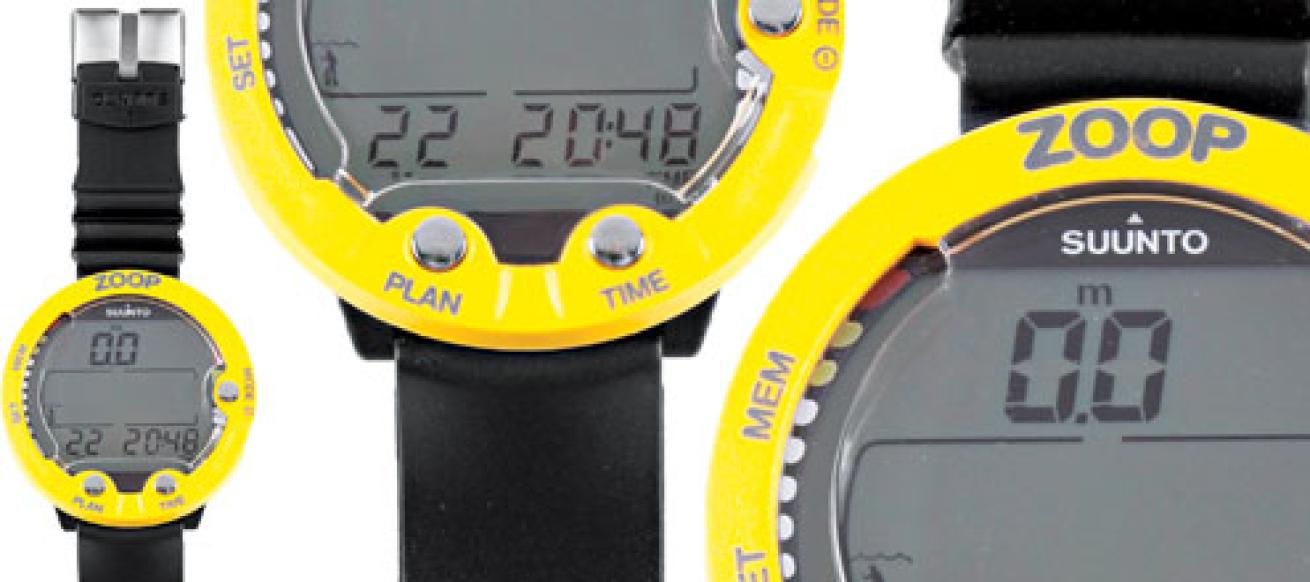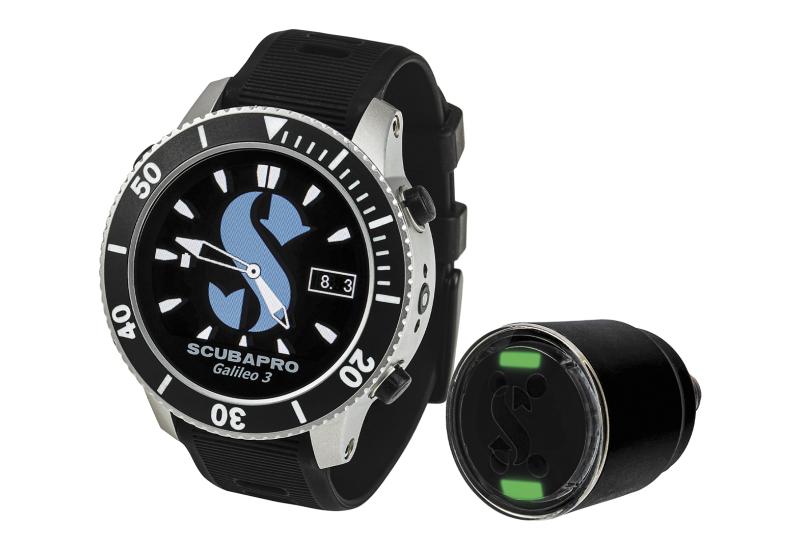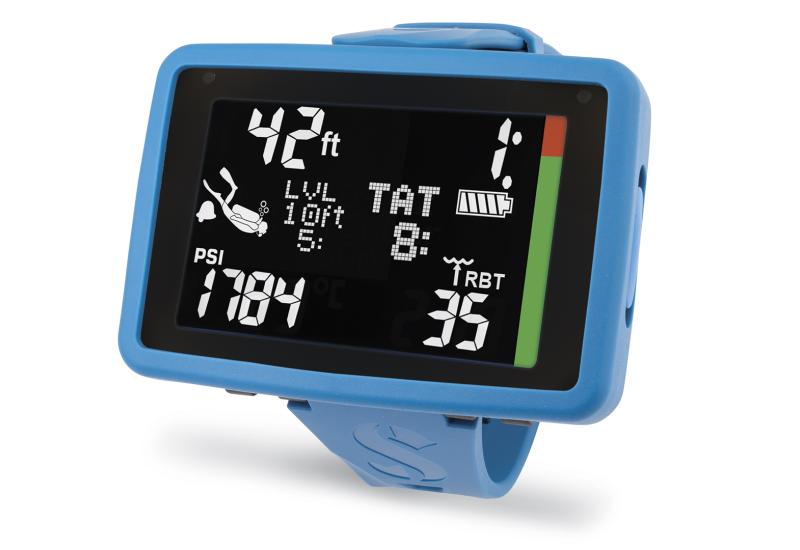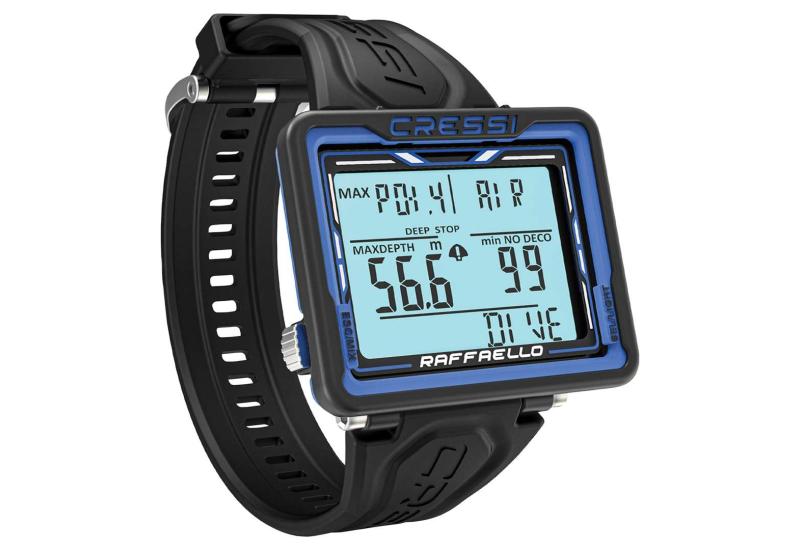Suunto Zoop Dive Computer: ScubaLab Review

Suunto Zoop Dive Computer
The Zoop diver computer is an excellent choice for any new scuba diver thanks to its ease-of-use, but it also offers features that make it appealing to more experienced divers.
Specifications
| Mounting Options | Wrist-mount, Console |
| Operational Modes | Air, Nitrox, Free Dive |
| User Controls | Three push buttons |
| Air-Integrated | No |
| PC Kit | Optional, $98 |
| Price | Wrist-Mount, $350; Two-Gauge Console, $475 |
| www.suunto.com/diving |
Suunto’s entry-level dive computer, the Zoop is based on the old Suunto Gekko but offers the ability to download dive data to a PC. The Zoop dive computer features a well-laid-out display with easy-to-read data digits, helpful graphics and intuitive white-yellow-red color bars that simplify monitoring N2 loading and ascent rate. Screen prompts like History, Memory, Nitrox, etc., are prominently displayed at the bottom of the screen so you can navigate through the system more easily. Plus, by grouping similar functions into separate menu sections, Suunto has created a more intuitive system that requires fewer button pushes to get where you want. On the downside, the Zoop’s phosphorescent LCD display for low-light conditions leaves much to be desired — it took a prolonged burst from a dive light to activate the phosphorescence, which then produced only dim and splotchy illumination. The same test on a backup model produced the same results.
Bottom Line
Slightly conservative, this is a simple-to-use DC for the beginner, while offering all the features a veteran recreational diver might need.
Check out the newest iteration of the Zoop dive computer in ScubaLab's 2016 dive computer test.
| September/October 2010 Issue Scuba Lab Review Quick Links |
|---|
| Basic Computers |
| --- |
| We define basic dive computers as single-gas units, nitrox capable to 50 percent. Computers in this category are good for recreational diving, plus they can function as backup computers or simple bottom timers for deep or technical diving. They range from no-frills, budget models to full-featured DCs with air integration. None of these DCs come with onboard compasses, although many come packaged in consoles that include traditional modular compasses. |
| Genesis React Pro| Oceanic ProPlus 2.1 |
| Sherwood Profile| Sherwood Insight |
| SUBGEAR XP10| SUUNTO D4 |
| SUUNTO Zoop| |
| Advanced Computers |
| --- |
| These are full-featured dive computers designed for divers who want the option of ratcheting up their diving experiences. Advanced computers allow you to program multiple mixes up to 100 percent oxygen that can be switched while at depth. They often also offer features like onboard compasses. |
| Atomic Aquatics Cobalt| Mares Icon HD |
| Oceanic Geo 2.0| |

Suunto Zoop Dive Computer
The Zoop diver computer is an excellent choice for any new scuba diver thanks to its ease-of-use, but it also offers features that make it appealing to more experienced divers.
Specifications
| Mounting Options | Wrist-mount, Console |
| Operational Modes | Air, Nitrox, Free Dive |
| User Controls | Three push buttons |
| Air-Integrated | No |
| PC Kit | Optional, $98 |
| Price | Wrist-Mount, $350; Two-Gauge Console, $475 |
| www.suunto.com/diving |
Suunto’s entry-level dive computer, the Zoop is based on the old Suunto Gekko but offers the ability to download dive data to a PC. The Zoop dive computer features a well-laid-out display with easy-to-read data digits, helpful graphics and intuitive white-yellow-red color bars that simplify monitoring N2 loading and ascent rate. Screen prompts like History, Memory, Nitrox, etc., are prominently displayed at the bottom of the screen so you can navigate through the system more easily. Plus, by grouping similar functions into separate menu sections, Suunto has created a more intuitive system that requires fewer button pushes to get where you want. On the downside, the Zoop’s phosphorescent LCD display for low-light conditions leaves much to be desired — it took a prolonged burst from a dive light to activate the phosphorescence, which then produced only dim and splotchy illumination. The same test on a backup model produced the same results.
Bottom Line
Slightly conservative, this is a simple-to-use DC for the beginner, while offering all the features a veteran recreational diver might need.
Check out the newest iteration of the Zoop dive computer in ScubaLab's 2016 dive computer test.
| September/October 2010 Issue Scuba Lab Review Quick Links |
|---|
| Basic Computers |
| --- |
| We define basic dive computers as single-gas units, nitrox capable to 50 percent. Computers in this category are good for recreational diving, plus they can function as backup computers or simple bottom timers for deep or technical diving. They range from no-frills, budget models to full-featured DCs with air integration. None of these DCs come with onboard compasses, although many come packaged in consoles that include traditional modular compasses. |
| Genesis React Pro| Oceanic ProPlus 2.1 |
| Sherwood Profile| Sherwood Insight |
| SUBGEAR XP10| SUUNTO D4| |
| SUUNTO Zoop| |
| Advanced Computers |
| --- |
| These are full-featured dive computers designed for divers who want the option of ratcheting up their diving experiences. Advanced computers allow you to program multiple mixes up to 100 percent oxygen that can be switched while at depth. They often also offer features like onboard compasses. |
| Atomic Aquatics Cobalt| | Mares Icon HD|
| Oceanic Geo 2.0| |










